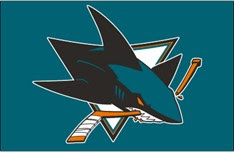Friday, April 26, 2024
San Jose Sharks
Professional hockey in the Bay Area can be traced to the San Francisco Shamrocks of the Pacific Coast Hockey League from 1944 to 1950. The Shark's origins began with the San Francisco Seals of the Western Hockey League (WHL) when they were awarded an expansion franchise for San Francisco on April 23rd, 1961, to former Vancouver Canucks owner Coleman (Coley) Hall, on the condition that an ice surface is installed in the Cow Palace. The Seals won three WHL championships and were renamed the California Seals in 1966, playing their games at the Oakland Coliseum Arena.
The following season, the California Golden Seals joined the NHL and played their seasons from 1967 to 1976, who were neither successful on the ice nor at the box office. Gordon and George Gund III became minority owners of the Seals in 1974 and were instrumental in their move to Cleveland in 1976 and a 1978 merger with the Minnesota North Stars, which they purchased that year. They had long wanted to bring hockey back to the Bay Area and asked the NHL for permission to move the North Stars there in the late 1980s, but the league vetoed the proposed move. Meanwhile, a group led by former Hartford Whalers owner Howard Baldwin was pushing the NHL to bring a team to San Jose, where a new arena was being built. Eventually, the League struck a compromise: the Gunds would sell their share of the North Stars to Baldwin’s group, with the Gunds receiving an expansion team in the Bay Area to begin play in the 1991-1992 season and being allowed to take a certain number of players from the North Stars to their new club(1). In return, the North Stars would be allowed to participate as an equal partner in an expansion draft with the latest Bay Area team. On May 5th, 1990, the Gunds officially sold their share of the North Stars to Baldwin and were awarded a new team for the Bay Area, based in San Jose. The owners paid the league an expansion fee of US$45 million(1) and the new franchise was approved on May 9th (2).
Over 5,000 potential names were submitted by mail for the new team. While the first-place was “Blades”, the Gunds were concerned about the name’s potentially negative association with weapons, and west with the runner-up “Sharks”(3)(4). The name was said to have been inspired by the many sharks living in the Pacific Ocean. Seven varieties live there, and one area of water near the Bay Area is known as the “red triangle” (hence the triangle in the team’s logo) because of its shark population.
Matt Levine – the team’s first marketing head – said of the new name, “Sharks are relentless, determined, swift, agile, bright and fearless. We plan to build an organization that has all those qualities.”(5)
Cow Palace years (1991-1993)
For their first two seasons, the Sharks played at the Cow Palace in Daly City, just outside San Francisco, a facility the NHL and the Seals had rejected in 1967. Pat Falloon was their first draft choice, leading the team in points during their first season. The team was placed in the Campbell Conference’s Smythe Division. George Kingston was their first head coach during their first two seasons(6). Though the 1991-1992 roster consisted primarily of NHL journeymen, minor leaguers, and rookies, the Sharks had at least one notable player when they acquired 14-year veteran and former Norris Trophy-winning defenseman Doug Wilson from the Chicago Blackhawks on September 6th, 1991. Wilson was named the team’s first team captain and All-Star representative in the inaugural season. However, the Sharks’ first two seasons saw the typical struggles for an expansion team. The 71 losses in 1992-1993 is an NHL record and they also suffered a 17-game losing streak, while winning just 11 games and earning a mere 24 points in the standing. Kingston was fired following the end of the 1992-1993 season.
Despite the Sharks’ futility in the standings, the team led the NHL’s merchandise sales with $150 million, accounting for 27% of the NHL’s total and behind only National Basketball Association champions Chicago Bulls among all North American leagues(7). Several team “firsts” happened in the 1992-1993 season. On November 17th, 1992 San Jose goaltender Arturs Irbe recorded the first shutout in team history, defeating the Los Angeles Kings 6-0. On December 3rd, against the Hartford Whalers at the Cow Palace, right winger Rob Gaudreau scored the first hat-trick in franchise history; he also scored the team’s second-ever hat-trick nine days later against the Quebec Nordiques.
The inaugural year also saw the introduction of the San Jose Sharks mascot, “S.J. Sharkie”. On January 28th, 1992, at a game against the New York Rangers, the then-unnamed mascot emerged from a Zamboni during an intermission. A “Name the Mascot” contest began that night, with the winning name of “S.J. Sharkie” being announced on April 15, 1992(8).
Resources:
1. https://www.reviewjournal.com/sports/golden
-knights-nhl/cost-of-nhl-expansion-team-goes
-from-2-million-to-500-million/
2. https://records.nhl.com/franchises/san-jose-
sharks/season-by-season-record
3. Donovan, Michael Leo (1997). The Name
Game: Football, Baseball, Hockey & Basketball
How Your Favorite Sports Teams Were Named.
Toronto: Warwick Publishing.
ISBN 1-895629-74-8.
4. Donovan, Michael Leo (1997). The Name
Game: Football, Baseball, Hockey & Basketball
How Your Favorite Sports Teams Were Named.
Toronto: Warwick Publishing.
ISBN 1-895629-74-8.
5. Gilmore, Tom (September 7, 1990). "Sharks
Are Coming – NHL Team Named". The San
Francisco Chronicle. The Chronicle Publishing
Co. p. D1. Retrieved April 21, 2007.
6. https://www.hockey-fans.com/pacific/sharks/
7. Sims, Calvin (December 14, 1992).
"In Disney's Hockey Venture, The Real
Action Is Off the Ice". The New York Times
8. Decade of Teal: 10 Years With the San Jose
Sharks. Woodford Publishing, Inc. 2001. p. 105.
Subscribe to:
Post Comments (Atom)


No comments:
Post a Comment